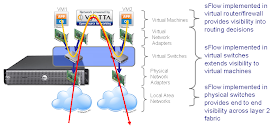The diagram shows networking elements within a virtual server. The server's physical network adapters connect to LAN switches that provide a high speed, flat, layer 2, fabric connecting servers and storage in the data center. Virtual switches provide shared access to the physical adapters, connecting the virtual network adapters in the virtual machines to the physical network.
Current hierarchical network designs confine routing to specialized hardware at the core of the network. It is worth re-examining the place of routing given the changes in data center architecture brought about by convergence and virtualization. What if routing could be virtualized?
The performance of software routers running on commodity x86 hardware is improving,
Vyatta recently announced
20 Gbps routing performance from their software routers. With
network adapter support for virtualization (e.g. SR-IOV), it is now feasible to implement high-performance routing and firewall functionality in virtual machines.
Virtualization of routing offers a number of advantages:
- Virtualization allows services to be replicated and deployed where they are needed in the virtual infrastructure. A virtual router can easily be replicated to provide redundancy or add capacity.
- Virtual routing can provide better reliability and lower costs by making use of the general purpose virtual server infrastructure, eliminating the need for expensive, specialized router hardware.
- Distributing routing to the edge of the network reduces pressure on the core and improves scalability.
There benefits don't just apply to routing, many other specialized devices can also be virtualized, including firewalls, load balancers, proxies etc. Virtualization of layer 3-7 network devices on a high performance
converged Ethernet fabric offers a flexible and dynamic infrastructure that can easily be reconfigured to meet changing demands.
To illustrate the potential of virtualized networking, consider the example of a hosted data center. In a typical hosted data center, customers have racks or partial racks of equipment installed in the data center. A typical customer will have their own router, firewall, load balancer and servers installed in the rack. A virtual rack can be constructed by deploying routing and firewall virtual machines along with general purpose virtual machines that the customer can use to deploy their applications. A virtual rack can be provisioned and maintained automatically, providing customers with much more responsive service while reducing operating costs. In addition, virtualization allows higher customer densities per physical rack, increasing the revenue that can be generated per rack.
The benefits aren't restricted to service provider networks. In enterprise data centers, the flexibility of virtualized networking allows for more efficient management and utilization of resources. However, a barrier to realizing these benefits is the current
siloed approach to data center management. Close coordination is needed between network and system management teams. For example, who would be responsible for provisioning and configuring a virtual router? This type of cross functional task is a challenge for most organizations.
Integrated
traffic monitoring provides the visibility needed for effective management of virtualized networks. The diagram shows some of the data paths that are possible in a virtual stack: the
red line shows traffic between two physical VLANs connected by a virtual router and the
gold line shows traffic routed between two virtual machines hosted on the same server. In order to provide
network visibility, every networking device, physical or virtual needs to include integrated traffic monitoring so that all traffic paths can be
observed. Shared visibility into all resources in the data center ensures that each group (network, systems and storage) is aware of its impact on shared resources, eliminates finger pointing, improves coordination and lays the foundation for
automating control.
There are many
proprietary and standard technologies for embedded traffic monitoring. Broadly speaking these fall into two classes, TCP/IP flow monitoring built into many routers (e.g. Cisco NetFlow) and multi-protocol
packet-based monitoring built into most switches. Convergence in both the LAN (
data center bridging) and the WAN (
Metro Ethernet and
Carrier Ethernet) is taking place using Ethernet technologies, making the
sFlow standard the logical choice for visibility since it enjoys broad,
multi-vendor support and is already built into most vendor's Ethernet products. Just as convergence to Ethernet simplifies connectivity, convergence to sFlow standard monitoring built into Ethernet devices simplifies management of the converged network.
Products incorporating the sFlow standard provide visibility throughout the
physical switch,
virtual switch,
virtual router and
cloud layers, delivering the end to end visibility needed to realize the full benefits of virtualization and convergence.







